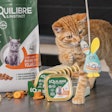A simple method to determine the mineral element composition of petfoods has been proposd by researchers in Brazil.
According to the research article: "Experimental design methodology was used to optimize an analytical method for determination of the mineral element composition (Al, Ca, Cd, Cr, Cu, Ba, Fe, K, Mg, Mn, P, S, Sr and Zn) of dog and cat foods. Two-level, full-factorial design was applied to define the optimal proportions of the reagents used for microwave-assisted sample digestion (2.0 mol L−1 HNO3 and 6 percent m/v H2O2).
"A three-level factorial design for two variables was used to optimize the operational conditions of the inductively coupled plasma optical emission spectrometer, employed for analysis of the extracts. A radiofrequency power of 1.2 kW and a nebulizer argon flow of 1.0 L min−1 were selected. The limits of quantification (LOQ) were between 0.03 μg g−1 (Cr, 267.716 nm) and 87 μg g-1 (Ca, 373.690 nm). The trueness of the optimized method was evaluated by analysis of five certified reference materials (CRMs): wheat flour (NIST 1567a), bovine liver (NIST 1577), peach leaves (NIST 1547), oyster tissue (NIST 1566b) and fish protein (DORM-3).
"The recovery values obtained for the CRMs were between 80±4 percent (Cr) and 117±5 percent (Cd), with relative standard deviations (RSDs) better than 5 percent, demonstrating that the proposed method offered good trueness and precision. Ten samples of petfood (five each of cat and dog food) were acquired at supermarkets in Aracaju city, Sergipe State, Brazil. Concentrations in the dog food ranged between 7.1 mg kg−1 (Ba) and 2.7 g kg−1 (Ca), while for cat food the values were between 3.7 mg kg−1 (Ba) and 3.0 g kg−1 (Ca). The concentrations of Ca, K, Mg, P, Cu, Fe, Mn and Zn in the food were compared with the guidelines of the United States Association of American Feed Control Officials and the Brazilian Ministry of Agriculture, Livestock and Food Supply (Ministério da Agricultura, Pecuária e Abastecimento-MAPA)."














